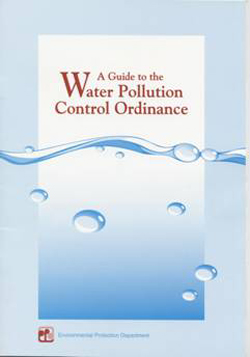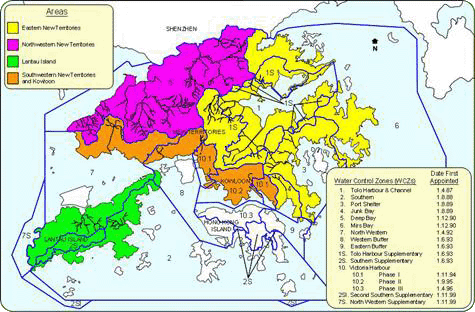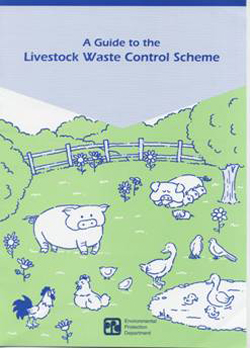The EPD’s system for assessing river water
quality will be described in detail in Chapter 2. Suffice it to say
for now that in 1986, the first year in which the newly formed EPD
began monitoring river water quality, some 45% of its monitoring
stations produced results that graded the river water as ‘Bad’ or
‘Very Bad’. The following year water quality deteriorated even
further, with 54% of monitoring stations recording ‘Bad’ or ‘Very Bad’
gradings. Simply put, Hong Kong’s river system was reaching a crisis
point, and concerted action was needed in order to put a stop to the
degradation of this crucial natural resource.
Government response: the Water Pollution Control Ordinance
 |
A guide to the Water Pollution Control Ordinance is available on the EPD website |
|
In the face of this deterioration in river
water quality, the Government over the past twenty years has
inaugurated a series of control measures designed to reverse the
trend. The foundation stone for this package of measures was the
enactment of the Water Pollution Control Ordinance (WPCO) in 1980.
This legislation put in place a basis for controlling pollution in the
waters of Hong Kong.
The Ordinance and later subsidiary legislation
allowed the Government to declare Water Control Zones (WCZs) within
Hong Kong. Each WCZ declared by the Government would have a set of
Water Quality Objectives developed that were appropriate for its
characteristics and its ‘beneficial uses’ (an expression that refers
to what the water in question is mostly used for, as for example
drinking, recreation, irrigation etc). This means that Water Quality
Objectives may differ from one WCZ to the next. These Water Quality
Objectives scientifically express the levels of water quality
necessary to achieve the conservation goals for each WCZ.
As each WCZ was declared, the EPD was given the job of enforcing
pollution controls in it with the goal of achieving and maintaining
the specified Water Quality Objectives for that WCZ. One major means
of control was a licensing system. Apart from the discharge of
domestic sewage into public sewers, under this system all industrial,
commercial, and institutional premises were required to obtain a
licence if they wanted to discharge effluent. Each licence specified
the terms and conditions of discharge including what pre-treatment was
necessary, and laid out the standards to be met. The EPD was given the
power to inspect all those discharging effluent to ensure that they
were complying with the terms and conditions of the discharge licence.
This would also involve making sure that wastewater treatment
facilities were being properly operated and maintained. In addition,
the EPD was given the authority to require property owners to connect
their wastewater to the public sewer system as it became available.
The WCZs were appointed gradually between 1987
and 1999. The accompanying map shows all ten WCZs and Supplementary
WCZs and the dates when they were first appointed. Each WCZ was
divided into subzones, and each subzone was allocated a specific set
of Water Quality Objectives. These Water Quality Objectives include a
series of clear parameters for assessing the quality of the water in
each WCZ. Those key parameters that the EPD monitors and uses for
calculating the WQO compliance rate include pH, dissolved oxygen,
5-day biochemical oxygen demand, chemical oxygen demand and suspended
solids. More detail about these parameters, and how and why they are
monitored, is given in Chapter 2.
 |
|
 |
|
| Map of the Water Control Zones and the dates they were first appointed |
|
|

|
 |
|
 |
The Livestock Waste Control Scheme
 |
A Guide to the Livestock Waste Control Scheme is distributed to livestock farmers |
|
A further Government
initiative to reduce and control water pollution was the Livestock
Waste Control Scheme, implemented under the Waste Disposal Ordinance,
which was introduced in 1987 and further revised in 1994. The Scheme
came about in response to the massive and indiscriminate discharge of
untreated livestock waste into rivers in the New Territories. This
major initiative designated a series of Prohibition Areas in which the
keeping of livestock was completely banned after 24 June 1988. The
Scheme significantly reduced the pollution from livestock farms in
Hong Kong. The accompanying map shows the areas designated as
Prohibition Areas, mostly within and around built-up urban areas.
Farmers outside the Prohibition Areas were
permitted to continue rearing livestock, but they were required to
properly dispose of their waste and treat their effluent so that it
complied with standards of no more than 50 mg/L of suspended solids
and 50 mg/L of 5-day biochemical oxygen demand by the mid-1990s.
The Government took several steps to help
farmers cope with the new regulations. It gave them technical help by
publishing a code of practice and guidelines on waste treatment
options, and by setting up a private farm demonstration treatment
plant. It also established a free livestock waste collection service,
and made financial help available for farmers to install their own
waste treatment facilities. Finally, the Government provided
incentives for farmers for whom the new system was too difficult: it
offered eligible farmers an ex gratia allowance if they chose to close
down their livestock business completely.
|